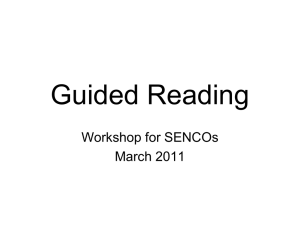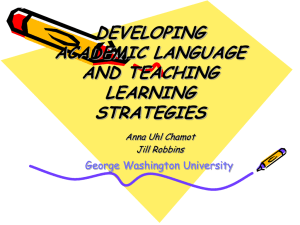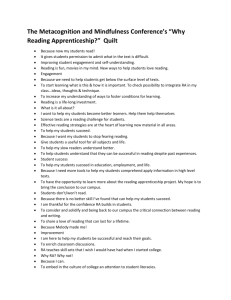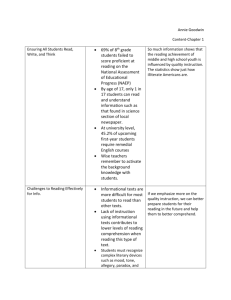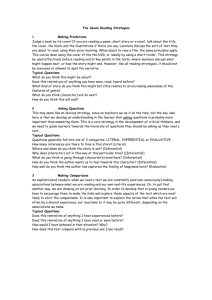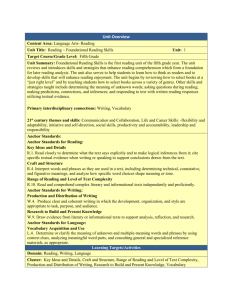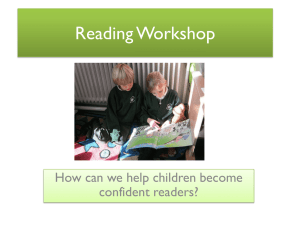IESPracticeGuideNotesJune22
advertisement
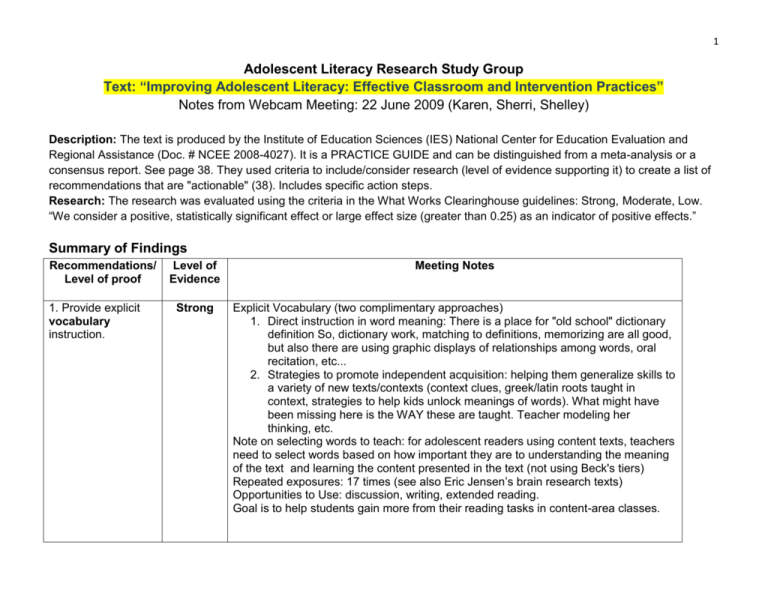
1 Adolescent Literacy Research Study Group Text: “Improving Adolescent Literacy: Effective Classroom and Intervention Practices” Notes from Webcam Meeting: 22 June 2009 (Karen, Sherri, Shelley) Description: The text is produced by the Institute of Education Sciences (IES) National Center for Education Evaluation and Regional Assistance (Doc. # NCEE 2008-4027). It is a PRACTICE GUIDE and can be distinguished from a meta-analysis or a consensus report. See page 38. They used criteria to include/consider research (level of evidence supporting it) to create a list of recommendations that are "actionable" (38). Includes specific action steps. Research: The research was evaluated using the criteria in the What Works Clearinghouse guidelines: Strong, Moderate, Low. “We consider a positive, statistically significant effect or large effect size (greater than 0.25) as an indicator of positive effects.” Summary of Findings Recommendations/ Level of proof 1. Provide explicit vocabulary instruction. Level of Evidence Meeting Notes Strong Explicit Vocabulary (two complimentary approaches) 1. Direct instruction in word meaning: There is a place for "old school" dictionary definition So, dictionary work, matching to definitions, memorizing are all good, but also there are using graphic displays of relationships among words, oral recitation, etc... 2. Strategies to promote independent acquisition: helping them generalize skills to a variety of new texts/contexts (context clues, greek/latin roots taught in context, strategies to help kids unlock meanings of words). What might have been missing here is the WAY these are taught. Teacher modeling her thinking, etc. Note on selecting words to teach: for adolescent readers using content texts, teachers need to select words based on how important they are to understanding the meaning of the text and learning the content presented in the text (not using Beck's tiers) Repeated exposures: 17 times (see also Eric Jensen’s brain research texts) Opportunities to Use: discussion, writing, extended reading. Goal is to help students gain more from their reading tasks in content-area classes. 2 2. Provide direct and explicit comprehension strategy instruction. 3. Provide opportunities for extended discussion of text meaning and interpretation. Strong Moderate It is really about the students' active participation in the comprehension process!! We must avoid comprehension strategy instruction becoming the end in itself. (19). These strategies are tools readers can use to actively participate. The end goal is always comprehension!! Questioning, Summarizing, and Use of Graphic organizers show strongest effect? pg. 17, second column, first complete paragraph Content teachers' responsibility because only they can authentically know what it takes to comprehend a discipline specific text. (Reading and writing strategies differ by discipline - make strategies targeted). PD Implications: The texts we use with teachers should be challenging for them! We should try to give teachers learning experiences that help them feel like struggling readers will feel, Teachers need to become conscious of the reading processes that are automatic for them (19). They must become metacognitive. They need to uncover their thinking processes so that they can think aloud as they navigate the text. We need to also include opportunities for them to practice doing think alouds even to a partner. We should have them bring texts they will be using with their students so they can practice authentically. They DO it! We cannot run out of time to do this piece. Consider beginning by DOING with a challenging text - not begin with the rationale and research and trainer talk. Here it says they need to use explicit instruction model / gradual release but how to connect this to what math and science already do. Do they have other language/models for explicit instruction? Scaffolding is also a new idea for many secondary teachers and may need to be hit harder. We need math/science specialists to collaborate with us to develop PD for content teachers. Teachers may fear the "transparency" of the think aloud The theory is that students will internalize thinking processes of how meaning can be constructed from texts and that these examples from others can serve as models for them during their reading. (22) High-quality discussions are ... Sustained, opinions defended, etc on p. 21 To create high-quality discussions, teachers must select engaging texts, ask reflection questions (not just questions to test whether they've read it)(these questions will differ from content to content) Connections to Socratic seminars and reciprocal teaching. Shelley has articles that compare 9 Discussion formats (Wilkinson article). We may want to devise PD that teaches various formats. Must also include classroom management skills if using formats that have less "teacher control" - (25). 3 4. Increase student motivation and engagement in literacy learning. Moderate 5. Make available intensive and individualized interventions for struggling readers that can be provided by trained specialists. Overall Conclusions Strong To foster motivation, help students toward authentic, personal learning goals. (28) and work to create self-regulated learners. Feedback should be informational but not controlling (must help students track progress toward their learning goals - formative assessments at classroom level as it can be used by students themselves as well as teachers) Help students set learning goals (not performance goals) Going beyond grades??!!! Praise effort (not ability) Need to foster intrinsic motivation; external rewards even backfire Need to put more in the hands of the learner, empower them "The more students know themselves as learners, the more confident... the more able to set own goals for learning." Connections: Ken uses Cambourne's Model of Learning (exact title?) John Guthrie work could be explored further. PD: A challenge here will be to show teachers what this looks like in a classroom... We need reliable methods for identifying struggling readers. Who is responsible for this? Someone in the system needs to have knowledge of and can administer screening tests, diagnostics, etc. Teachers can use teaching aids/devices to help struggling readers understand and remember content (36). PLC time could be used to foster communication among content/ELA, interventionists. Connections: SIM is being used in Arkansas (teaching aids/devices listed above) Throughout these recommendations, we see the importance of Student centered learning environment; student given choice and taking responsibility for learning; Students being metacognitive; being active learners; intrinsic; instruction being authentic and relevant and teacher not always “controlling” all General thoughts regarding PD: There is much here to be conveyed to content teachers. We must share it in a spirit of partnership and respect. Perhaps pull excerpts from articles like this to have content teachers read and discuss rather than having us stand and preach about rationale for content teachers improving practices for struggling readers/learners. We need to build on what teachers are already doing; not asking them to throw out baby with bathwater. We need to help teachers experience these strategies in the PD as learners. 4

